Strategies for Preventing Adverse Events and Effective Communication
VerifiedAdded on 2023/06/03
|12
|2785
|449
Essay
AI Summary
This essay provides a comprehensive analysis of adverse events in healthcare, focusing on their prevention and the importance of effective communication in patient care. It identifies common adverse events such as medication errors, falls, hospital-acquired infections, and malnutrition, and discusses strategies to mitigate these risks. The paper highlights the necessity of clear and empathetic communication between healthcare professionals and patients to reduce stress, anxiety, and the likelihood of adverse events. It also addresses the steps to take immediately following an adverse event, emphasizing patient-centric care, transparent communication, proper reporting, and accurate medical record-keeping. The essay concludes that effective communication is a crucial factor in ensuring patient safety and improving overall healthcare outcomes.
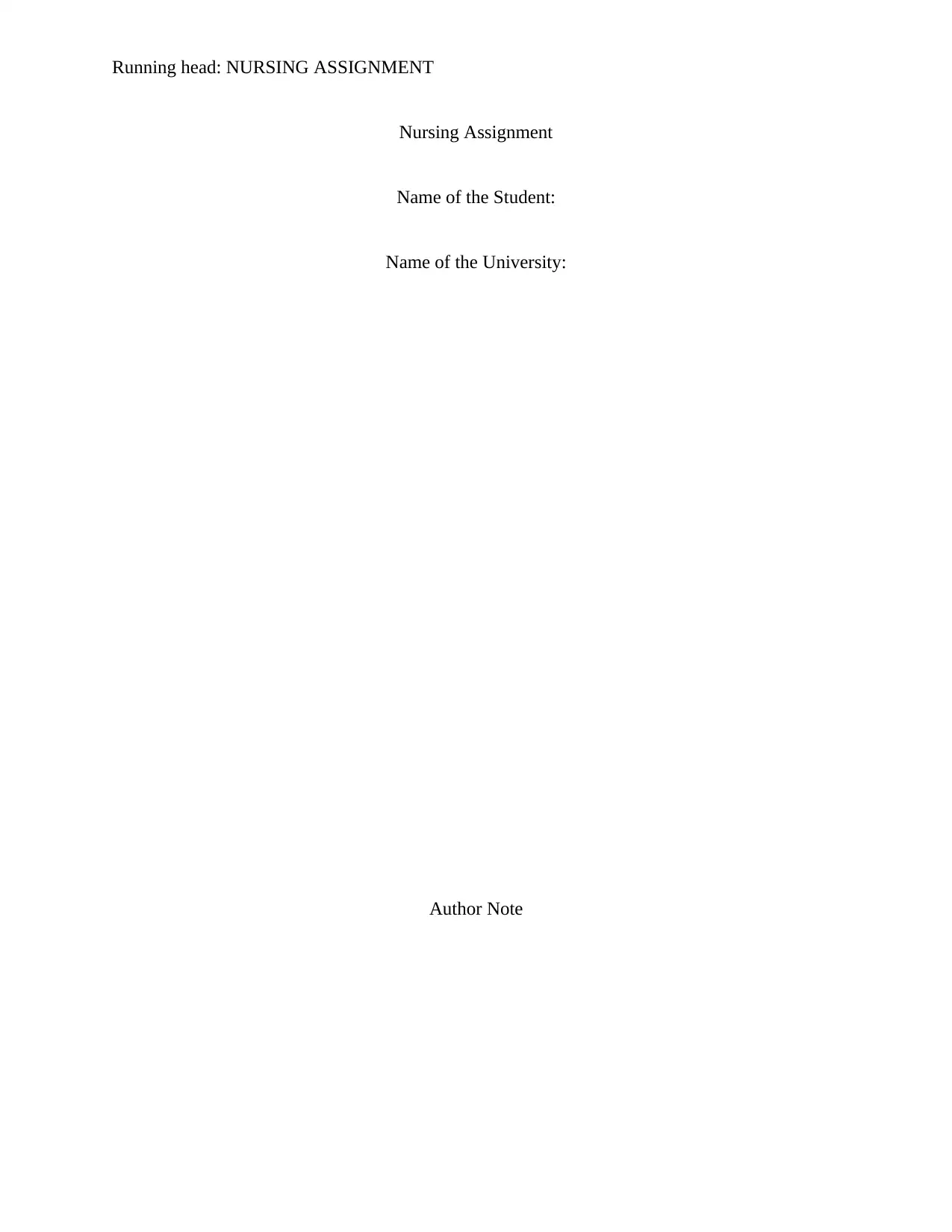
Running head: NURSING ASSIGNMENT
Nursing Assignment
Name of the Student:
Name of the University:
Author Note
Nursing Assignment
Name of the Student:
Name of the University:
Author Note
Paraphrase This Document
Need a fresh take? Get an instant paraphrase of this document with our AI Paraphraser
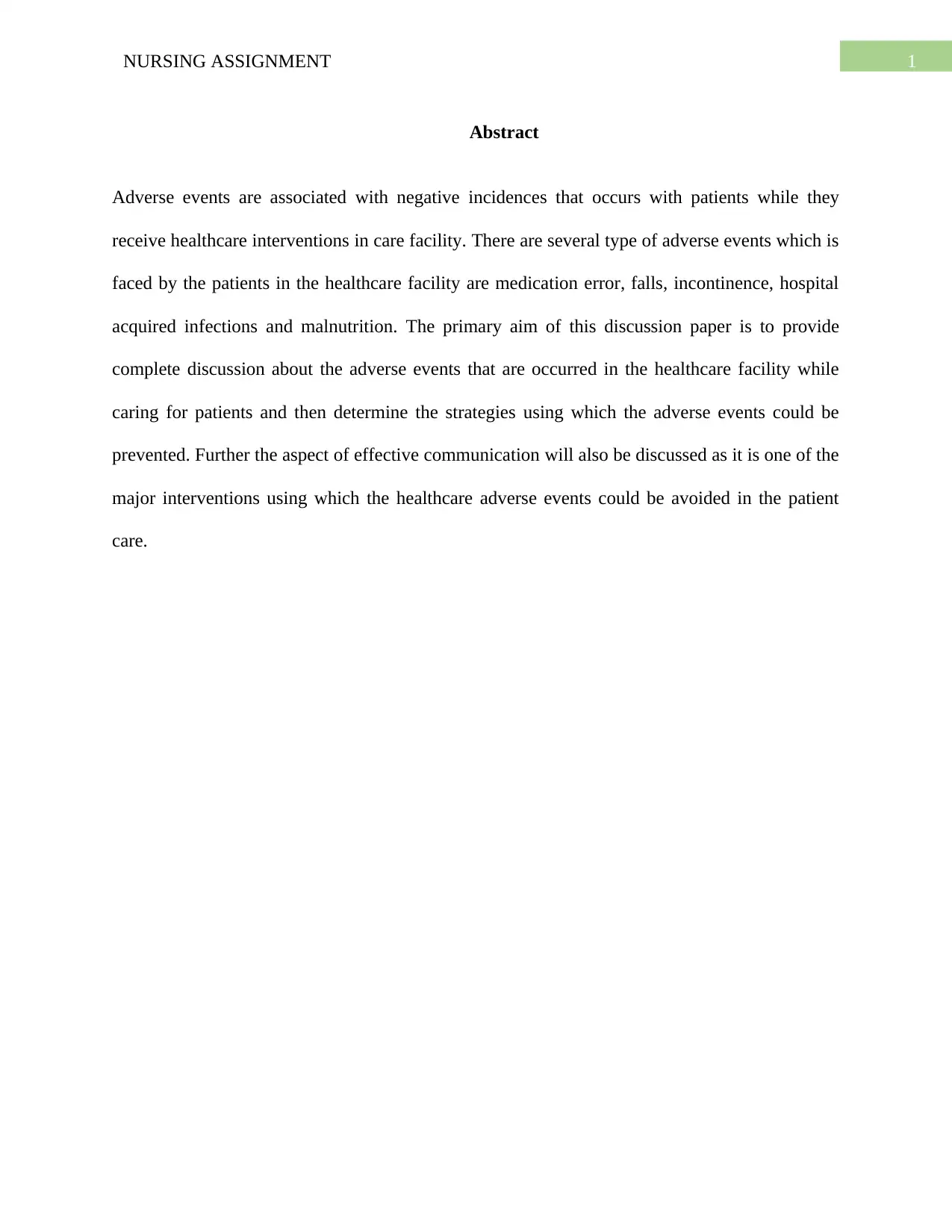
1NURSING ASSIGNMENT
Abstract
Adverse events are associated with negative incidences that occurs with patients while they
receive healthcare interventions in care facility. There are several type of adverse events which is
faced by the patients in the healthcare facility are medication error, falls, incontinence, hospital
acquired infections and malnutrition. The primary aim of this discussion paper is to provide
complete discussion about the adverse events that are occurred in the healthcare facility while
caring for patients and then determine the strategies using which the adverse events could be
prevented. Further the aspect of effective communication will also be discussed as it is one of the
major interventions using which the healthcare adverse events could be avoided in the patient
care.
Abstract
Adverse events are associated with negative incidences that occurs with patients while they
receive healthcare interventions in care facility. There are several type of adverse events which is
faced by the patients in the healthcare facility are medication error, falls, incontinence, hospital
acquired infections and malnutrition. The primary aim of this discussion paper is to provide
complete discussion about the adverse events that are occurred in the healthcare facility while
caring for patients and then determine the strategies using which the adverse events could be
prevented. Further the aspect of effective communication will also be discussed as it is one of the
major interventions using which the healthcare adverse events could be avoided in the patient
care.
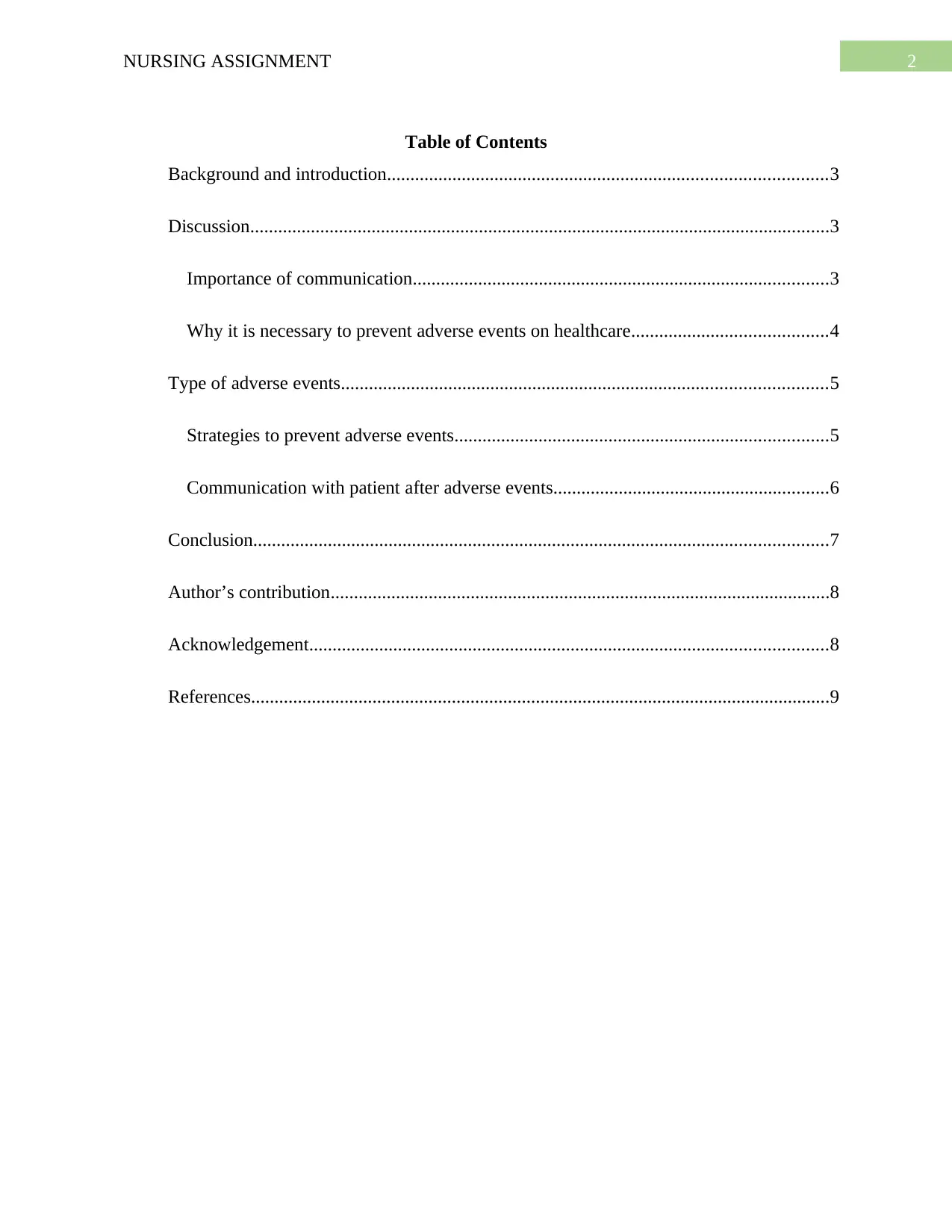
2NURSING ASSIGNMENT
Table of Contents
Background and introduction..............................................................................................3
Discussion............................................................................................................................3
Importance of communication.........................................................................................3
Why it is necessary to prevent adverse events on healthcare..........................................4
Type of adverse events........................................................................................................5
Strategies to prevent adverse events................................................................................5
Communication with patient after adverse events...........................................................6
Conclusion...........................................................................................................................7
Author’s contribution...........................................................................................................8
Acknowledgement...............................................................................................................8
References............................................................................................................................9
Table of Contents
Background and introduction..............................................................................................3
Discussion............................................................................................................................3
Importance of communication.........................................................................................3
Why it is necessary to prevent adverse events on healthcare..........................................4
Type of adverse events........................................................................................................5
Strategies to prevent adverse events................................................................................5
Communication with patient after adverse events...........................................................6
Conclusion...........................................................................................................................7
Author’s contribution...........................................................................................................8
Acknowledgement...............................................................................................................8
References............................................................................................................................9
⊘ This is a preview!⊘
Do you want full access?
Subscribe today to unlock all pages.

Trusted by 1+ million students worldwide
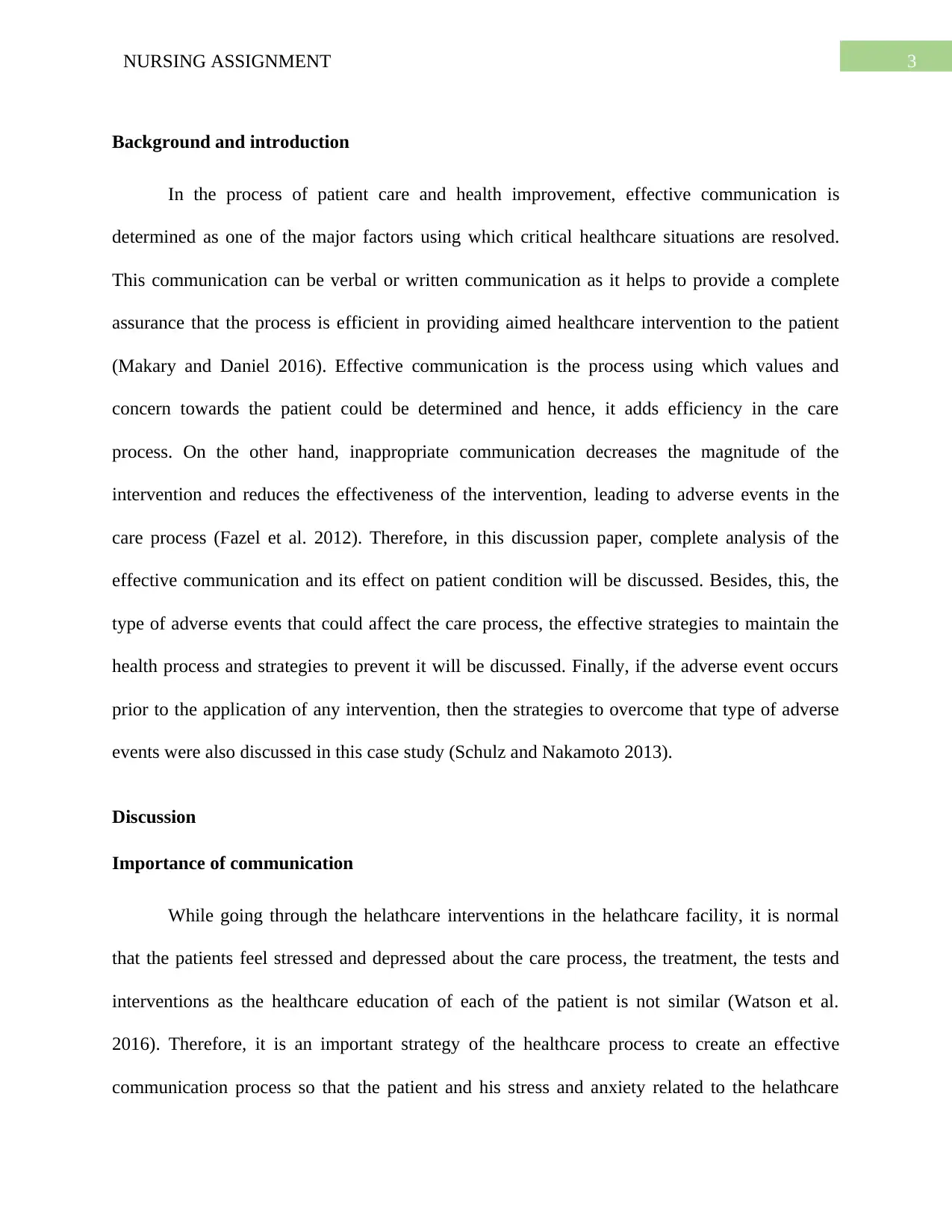
3NURSING ASSIGNMENT
Background and introduction
In the process of patient care and health improvement, effective communication is
determined as one of the major factors using which critical healthcare situations are resolved.
This communication can be verbal or written communication as it helps to provide a complete
assurance that the process is efficient in providing aimed healthcare intervention to the patient
(Makary and Daniel 2016). Effective communication is the process using which values and
concern towards the patient could be determined and hence, it adds efficiency in the care
process. On the other hand, inappropriate communication decreases the magnitude of the
intervention and reduces the effectiveness of the intervention, leading to adverse events in the
care process (Fazel et al. 2012). Therefore, in this discussion paper, complete analysis of the
effective communication and its effect on patient condition will be discussed. Besides, this, the
type of adverse events that could affect the care process, the effective strategies to maintain the
health process and strategies to prevent it will be discussed. Finally, if the adverse event occurs
prior to the application of any intervention, then the strategies to overcome that type of adverse
events were also discussed in this case study (Schulz and Nakamoto 2013).
Discussion
Importance of communication
While going through the helathcare interventions in the helathcare facility, it is normal
that the patients feel stressed and depressed about the care process, the treatment, the tests and
interventions as the healthcare education of each of the patient is not similar (Watson et al.
2016). Therefore, it is an important strategy of the healthcare process to create an effective
communication process so that the patient and his stress and anxiety related to the helathcare
Background and introduction
In the process of patient care and health improvement, effective communication is
determined as one of the major factors using which critical healthcare situations are resolved.
This communication can be verbal or written communication as it helps to provide a complete
assurance that the process is efficient in providing aimed healthcare intervention to the patient
(Makary and Daniel 2016). Effective communication is the process using which values and
concern towards the patient could be determined and hence, it adds efficiency in the care
process. On the other hand, inappropriate communication decreases the magnitude of the
intervention and reduces the effectiveness of the intervention, leading to adverse events in the
care process (Fazel et al. 2012). Therefore, in this discussion paper, complete analysis of the
effective communication and its effect on patient condition will be discussed. Besides, this, the
type of adverse events that could affect the care process, the effective strategies to maintain the
health process and strategies to prevent it will be discussed. Finally, if the adverse event occurs
prior to the application of any intervention, then the strategies to overcome that type of adverse
events were also discussed in this case study (Schulz and Nakamoto 2013).
Discussion
Importance of communication
While going through the helathcare interventions in the helathcare facility, it is normal
that the patients feel stressed and depressed about the care process, the treatment, the tests and
interventions as the healthcare education of each of the patient is not similar (Watson et al.
2016). Therefore, it is an important strategy of the healthcare process to create an effective
communication process so that the patient and his stress and anxiety related to the helathcare
Paraphrase This Document
Need a fresh take? Get an instant paraphrase of this document with our AI Paraphraser
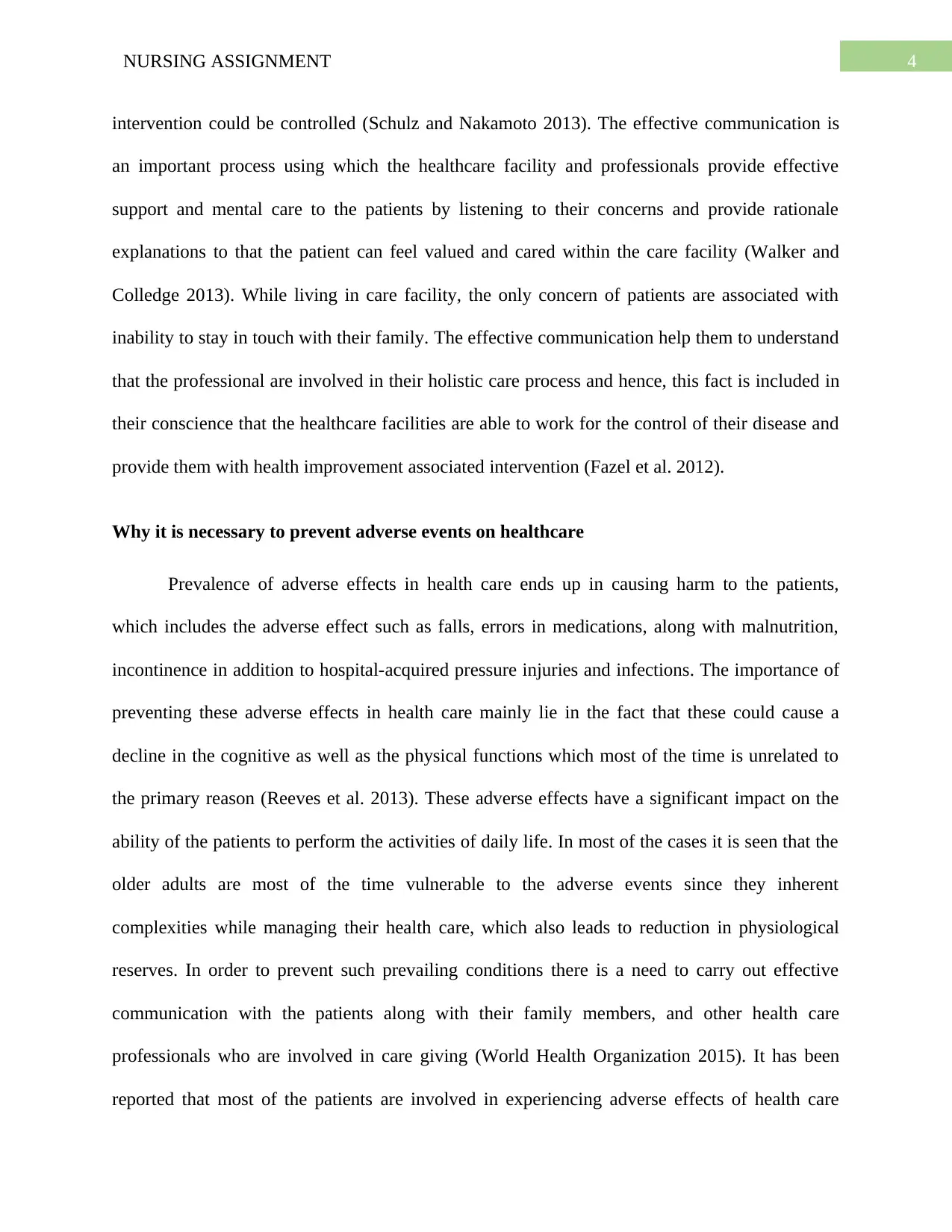
4NURSING ASSIGNMENT
intervention could be controlled (Schulz and Nakamoto 2013). The effective communication is
an important process using which the healthcare facility and professionals provide effective
support and mental care to the patients by listening to their concerns and provide rationale
explanations to that the patient can feel valued and cared within the care facility (Walker and
Colledge 2013). While living in care facility, the only concern of patients are associated with
inability to stay in touch with their family. The effective communication help them to understand
that the professional are involved in their holistic care process and hence, this fact is included in
their conscience that the healthcare facilities are able to work for the control of their disease and
provide them with health improvement associated intervention (Fazel et al. 2012).
Why it is necessary to prevent adverse events on healthcare
Prevalence of adverse effects in health care ends up in causing harm to the patients,
which includes the adverse effect such as falls, errors in medications, along with malnutrition,
incontinence in addition to hospital-acquired pressure injuries and infections. The importance of
preventing these adverse effects in health care mainly lie in the fact that these could cause a
decline in the cognitive as well as the physical functions which most of the time is unrelated to
the primary reason (Reeves et al. 2013). These adverse effects have a significant impact on the
ability of the patients to perform the activities of daily life. In most of the cases it is seen that the
older adults are most of the time vulnerable to the adverse events since they inherent
complexities while managing their health care, which also leads to reduction in physiological
reserves. In order to prevent such prevailing conditions there is a need to carry out effective
communication with the patients along with their family members, and other health care
professionals who are involved in care giving (World Health Organization 2015). It has been
reported that most of the patients are involved in experiencing adverse effects of health care
intervention could be controlled (Schulz and Nakamoto 2013). The effective communication is
an important process using which the healthcare facility and professionals provide effective
support and mental care to the patients by listening to their concerns and provide rationale
explanations to that the patient can feel valued and cared within the care facility (Walker and
Colledge 2013). While living in care facility, the only concern of patients are associated with
inability to stay in touch with their family. The effective communication help them to understand
that the professional are involved in their holistic care process and hence, this fact is included in
their conscience that the healthcare facilities are able to work for the control of their disease and
provide them with health improvement associated intervention (Fazel et al. 2012).
Why it is necessary to prevent adverse events on healthcare
Prevalence of adverse effects in health care ends up in causing harm to the patients,
which includes the adverse effect such as falls, errors in medications, along with malnutrition,
incontinence in addition to hospital-acquired pressure injuries and infections. The importance of
preventing these adverse effects in health care mainly lie in the fact that these could cause a
decline in the cognitive as well as the physical functions which most of the time is unrelated to
the primary reason (Reeves et al. 2013). These adverse effects have a significant impact on the
ability of the patients to perform the activities of daily life. In most of the cases it is seen that the
older adults are most of the time vulnerable to the adverse events since they inherent
complexities while managing their health care, which also leads to reduction in physiological
reserves. In order to prevent such prevailing conditions there is a need to carry out effective
communication with the patients along with their family members, and other health care
professionals who are involved in care giving (World Health Organization 2015). It has been
reported that most of the patients are involved in experiencing adverse effects of health care
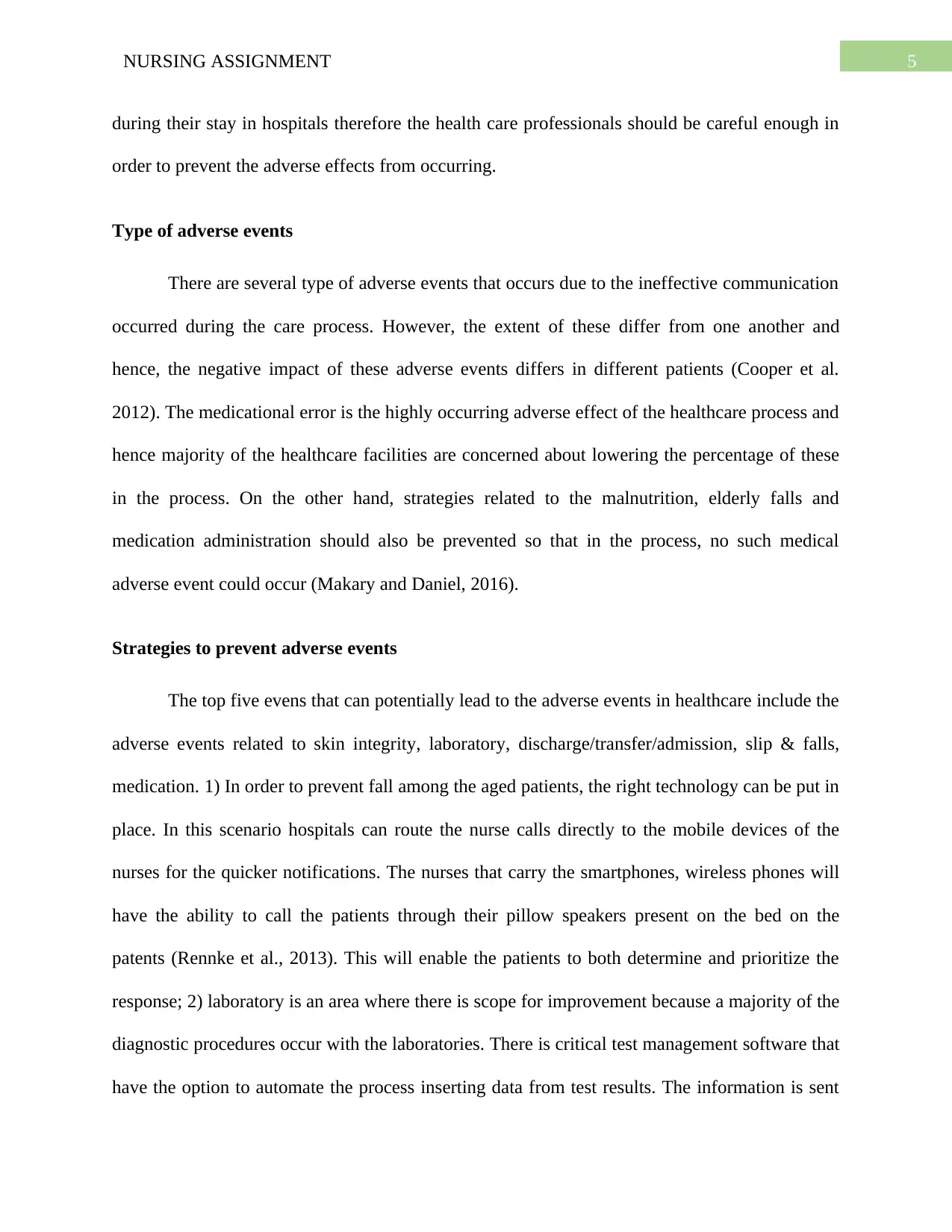
5NURSING ASSIGNMENT
during their stay in hospitals therefore the health care professionals should be careful enough in
order to prevent the adverse effects from occurring.
Type of adverse events
There are several type of adverse events that occurs due to the ineffective communication
occurred during the care process. However, the extent of these differ from one another and
hence, the negative impact of these adverse events differs in different patients (Cooper et al.
2012). The medicational error is the highly occurring adverse effect of the healthcare process and
hence majority of the healthcare facilities are concerned about lowering the percentage of these
in the process. On the other hand, strategies related to the malnutrition, elderly falls and
medication administration should also be prevented so that in the process, no such medical
adverse event could occur (Makary and Daniel, 2016).
Strategies to prevent adverse events
The top five evens that can potentially lead to the adverse events in healthcare include the
adverse events related to skin integrity, laboratory, discharge/transfer/admission, slip & falls,
medication. 1) In order to prevent fall among the aged patients, the right technology can be put in
place. In this scenario hospitals can route the nurse calls directly to the mobile devices of the
nurses for the quicker notifications. The nurses that carry the smartphones, wireless phones will
have the ability to call the patients through their pillow speakers present on the bed on the
patents (Rennke et al., 2013). This will enable the patients to both determine and prioritize the
response; 2) laboratory is an area where there is scope for improvement because a majority of the
diagnostic procedures occur with the laboratories. There is critical test management software that
have the option to automate the process inserting data from test results. The information is sent
during their stay in hospitals therefore the health care professionals should be careful enough in
order to prevent the adverse effects from occurring.
Type of adverse events
There are several type of adverse events that occurs due to the ineffective communication
occurred during the care process. However, the extent of these differ from one another and
hence, the negative impact of these adverse events differs in different patients (Cooper et al.
2012). The medicational error is the highly occurring adverse effect of the healthcare process and
hence majority of the healthcare facilities are concerned about lowering the percentage of these
in the process. On the other hand, strategies related to the malnutrition, elderly falls and
medication administration should also be prevented so that in the process, no such medical
adverse event could occur (Makary and Daniel, 2016).
Strategies to prevent adverse events
The top five evens that can potentially lead to the adverse events in healthcare include the
adverse events related to skin integrity, laboratory, discharge/transfer/admission, slip & falls,
medication. 1) In order to prevent fall among the aged patients, the right technology can be put in
place. In this scenario hospitals can route the nurse calls directly to the mobile devices of the
nurses for the quicker notifications. The nurses that carry the smartphones, wireless phones will
have the ability to call the patients through their pillow speakers present on the bed on the
patents (Rennke et al., 2013). This will enable the patients to both determine and prioritize the
response; 2) laboratory is an area where there is scope for improvement because a majority of the
diagnostic procedures occur with the laboratories. There is critical test management software that
have the option to automate the process inserting data from test results. The information is sent
⊘ This is a preview!⊘
Do you want full access?
Subscribe today to unlock all pages.

Trusted by 1+ million students worldwide
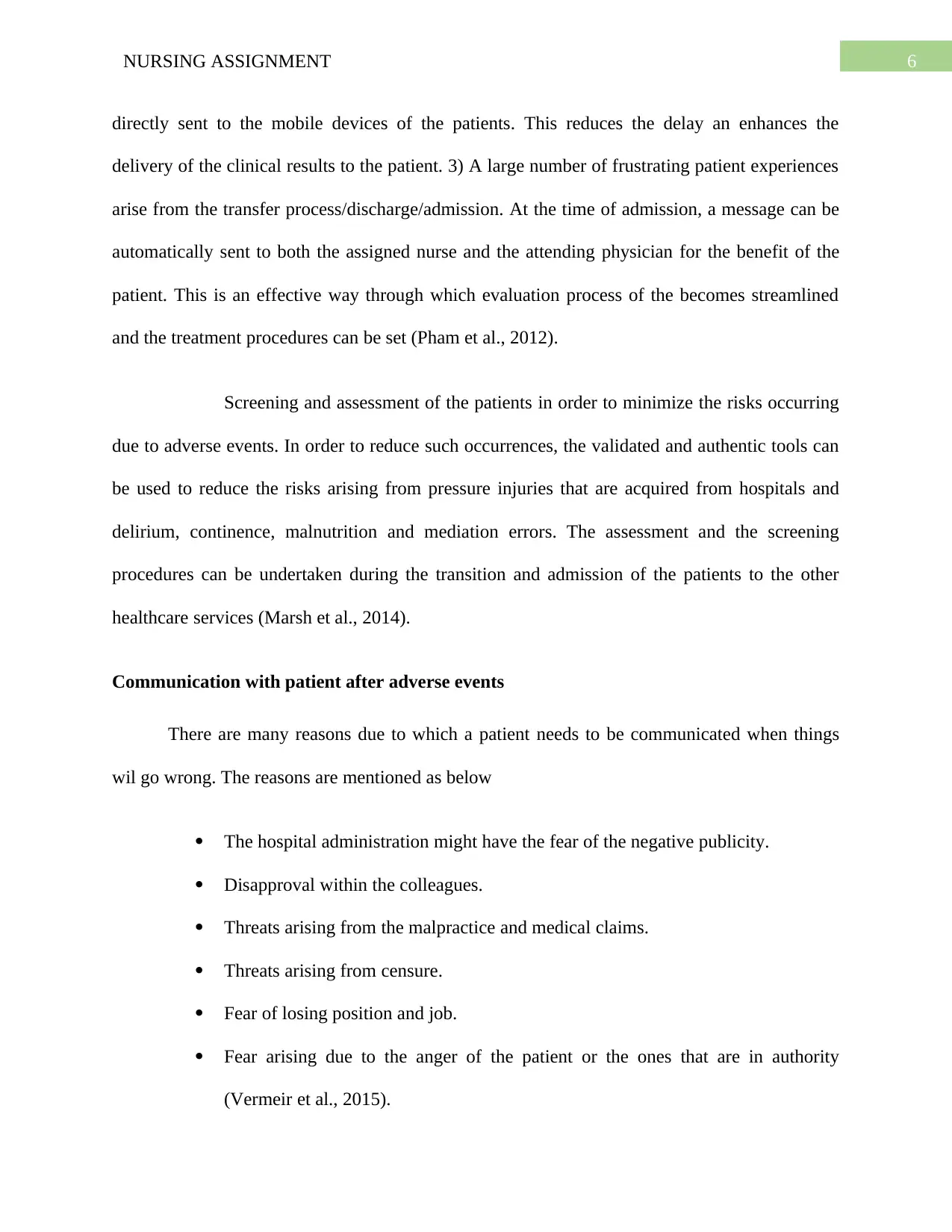
6NURSING ASSIGNMENT
directly sent to the mobile devices of the patients. This reduces the delay an enhances the
delivery of the clinical results to the patient. 3) A large number of frustrating patient experiences
arise from the transfer process/discharge/admission. At the time of admission, a message can be
automatically sent to both the assigned nurse and the attending physician for the benefit of the
patient. This is an effective way through which evaluation process of the becomes streamlined
and the treatment procedures can be set (Pham et al., 2012).
Screening and assessment of the patients in order to minimize the risks occurring
due to adverse events. In order to reduce such occurrences, the validated and authentic tools can
be used to reduce the risks arising from pressure injuries that are acquired from hospitals and
delirium, continence, malnutrition and mediation errors. The assessment and the screening
procedures can be undertaken during the transition and admission of the patients to the other
healthcare services (Marsh et al., 2014).
Communication with patient after adverse events
There are many reasons due to which a patient needs to be communicated when things
wil go wrong. The reasons are mentioned as below
The hospital administration might have the fear of the negative publicity.
Disapproval within the colleagues.
Threats arising from the malpractice and medical claims.
Threats arising from censure.
Fear of losing position and job.
Fear arising due to the anger of the patient or the ones that are in authority
(Vermeir et al., 2015).
directly sent to the mobile devices of the patients. This reduces the delay an enhances the
delivery of the clinical results to the patient. 3) A large number of frustrating patient experiences
arise from the transfer process/discharge/admission. At the time of admission, a message can be
automatically sent to both the assigned nurse and the attending physician for the benefit of the
patient. This is an effective way through which evaluation process of the becomes streamlined
and the treatment procedures can be set (Pham et al., 2012).
Screening and assessment of the patients in order to minimize the risks occurring
due to adverse events. In order to reduce such occurrences, the validated and authentic tools can
be used to reduce the risks arising from pressure injuries that are acquired from hospitals and
delirium, continence, malnutrition and mediation errors. The assessment and the screening
procedures can be undertaken during the transition and admission of the patients to the other
healthcare services (Marsh et al., 2014).
Communication with patient after adverse events
There are many reasons due to which a patient needs to be communicated when things
wil go wrong. The reasons are mentioned as below
The hospital administration might have the fear of the negative publicity.
Disapproval within the colleagues.
Threats arising from the malpractice and medical claims.
Threats arising from censure.
Fear of losing position and job.
Fear arising due to the anger of the patient or the ones that are in authority
(Vermeir et al., 2015).
Paraphrase This Document
Need a fresh take? Get an instant paraphrase of this document with our AI Paraphraser
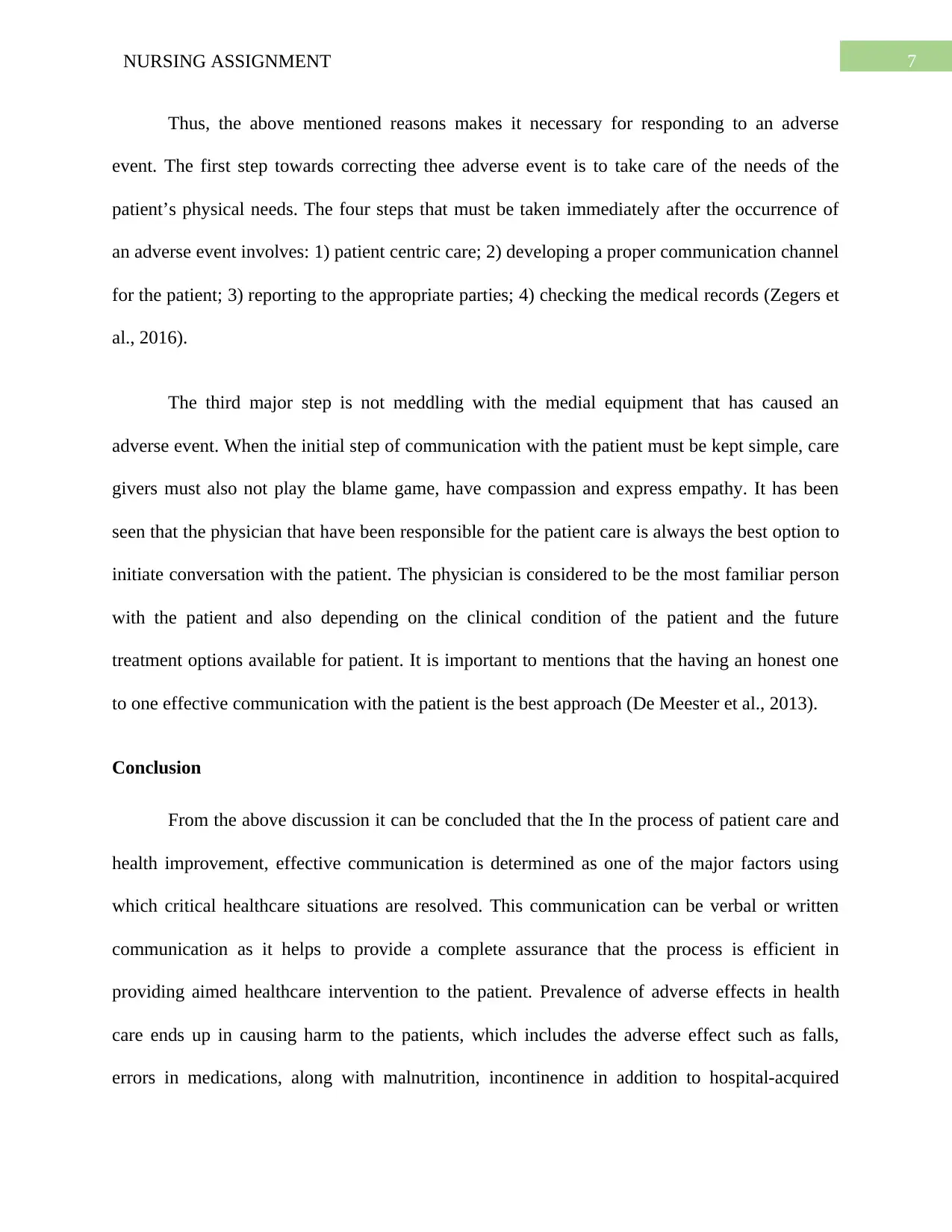
7NURSING ASSIGNMENT
Thus, the above mentioned reasons makes it necessary for responding to an adverse
event. The first step towards correcting thee adverse event is to take care of the needs of the
patient’s physical needs. The four steps that must be taken immediately after the occurrence of
an adverse event involves: 1) patient centric care; 2) developing a proper communication channel
for the patient; 3) reporting to the appropriate parties; 4) checking the medical records (Zegers et
al., 2016).
The third major step is not meddling with the medial equipment that has caused an
adverse event. When the initial step of communication with the patient must be kept simple, care
givers must also not play the blame game, have compassion and express empathy. It has been
seen that the physician that have been responsible for the patient care is always the best option to
initiate conversation with the patient. The physician is considered to be the most familiar person
with the patient and also depending on the clinical condition of the patient and the future
treatment options available for patient. It is important to mentions that the having an honest one
to one effective communication with the patient is the best approach (De Meester et al., 2013).
Conclusion
From the above discussion it can be concluded that the In the process of patient care and
health improvement, effective communication is determined as one of the major factors using
which critical healthcare situations are resolved. This communication can be verbal or written
communication as it helps to provide a complete assurance that the process is efficient in
providing aimed healthcare intervention to the patient. Prevalence of adverse effects in health
care ends up in causing harm to the patients, which includes the adverse effect such as falls,
errors in medications, along with malnutrition, incontinence in addition to hospital-acquired
Thus, the above mentioned reasons makes it necessary for responding to an adverse
event. The first step towards correcting thee adverse event is to take care of the needs of the
patient’s physical needs. The four steps that must be taken immediately after the occurrence of
an adverse event involves: 1) patient centric care; 2) developing a proper communication channel
for the patient; 3) reporting to the appropriate parties; 4) checking the medical records (Zegers et
al., 2016).
The third major step is not meddling with the medial equipment that has caused an
adverse event. When the initial step of communication with the patient must be kept simple, care
givers must also not play the blame game, have compassion and express empathy. It has been
seen that the physician that have been responsible for the patient care is always the best option to
initiate conversation with the patient. The physician is considered to be the most familiar person
with the patient and also depending on the clinical condition of the patient and the future
treatment options available for patient. It is important to mentions that the having an honest one
to one effective communication with the patient is the best approach (De Meester et al., 2013).
Conclusion
From the above discussion it can be concluded that the In the process of patient care and
health improvement, effective communication is determined as one of the major factors using
which critical healthcare situations are resolved. This communication can be verbal or written
communication as it helps to provide a complete assurance that the process is efficient in
providing aimed healthcare intervention to the patient. Prevalence of adverse effects in health
care ends up in causing harm to the patients, which includes the adverse effect such as falls,
errors in medications, along with malnutrition, incontinence in addition to hospital-acquired
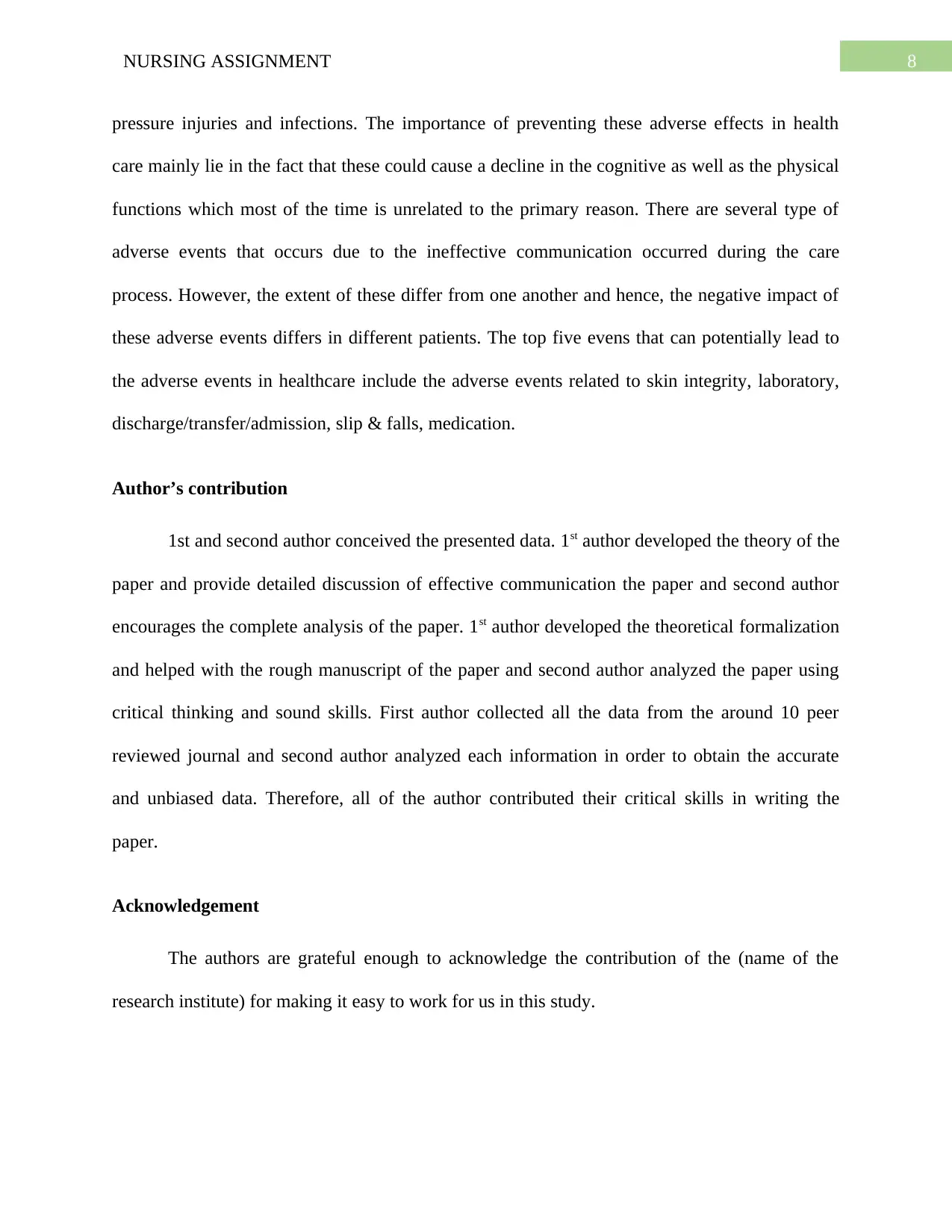
8NURSING ASSIGNMENT
pressure injuries and infections. The importance of preventing these adverse effects in health
care mainly lie in the fact that these could cause a decline in the cognitive as well as the physical
functions which most of the time is unrelated to the primary reason. There are several type of
adverse events that occurs due to the ineffective communication occurred during the care
process. However, the extent of these differ from one another and hence, the negative impact of
these adverse events differs in different patients. The top five evens that can potentially lead to
the adverse events in healthcare include the adverse events related to skin integrity, laboratory,
discharge/transfer/admission, slip & falls, medication.
Author’s contribution
1st and second author conceived the presented data. 1st author developed the theory of the
paper and provide detailed discussion of effective communication the paper and second author
encourages the complete analysis of the paper. 1st author developed the theoretical formalization
and helped with the rough manuscript of the paper and second author analyzed the paper using
critical thinking and sound skills. First author collected all the data from the around 10 peer
reviewed journal and second author analyzed each information in order to obtain the accurate
and unbiased data. Therefore, all of the author contributed their critical skills in writing the
paper.
Acknowledgement
The authors are grateful enough to acknowledge the contribution of the (name of the
research institute) for making it easy to work for us in this study.
pressure injuries and infections. The importance of preventing these adverse effects in health
care mainly lie in the fact that these could cause a decline in the cognitive as well as the physical
functions which most of the time is unrelated to the primary reason. There are several type of
adverse events that occurs due to the ineffective communication occurred during the care
process. However, the extent of these differ from one another and hence, the negative impact of
these adverse events differs in different patients. The top five evens that can potentially lead to
the adverse events in healthcare include the adverse events related to skin integrity, laboratory,
discharge/transfer/admission, slip & falls, medication.
Author’s contribution
1st and second author conceived the presented data. 1st author developed the theory of the
paper and provide detailed discussion of effective communication the paper and second author
encourages the complete analysis of the paper. 1st author developed the theoretical formalization
and helped with the rough manuscript of the paper and second author analyzed the paper using
critical thinking and sound skills. First author collected all the data from the around 10 peer
reviewed journal and second author analyzed each information in order to obtain the accurate
and unbiased data. Therefore, all of the author contributed their critical skills in writing the
paper.
Acknowledgement
The authors are grateful enough to acknowledge the contribution of the (name of the
research institute) for making it easy to work for us in this study.
⊘ This is a preview!⊘
Do you want full access?
Subscribe today to unlock all pages.

Trusted by 1+ million students worldwide
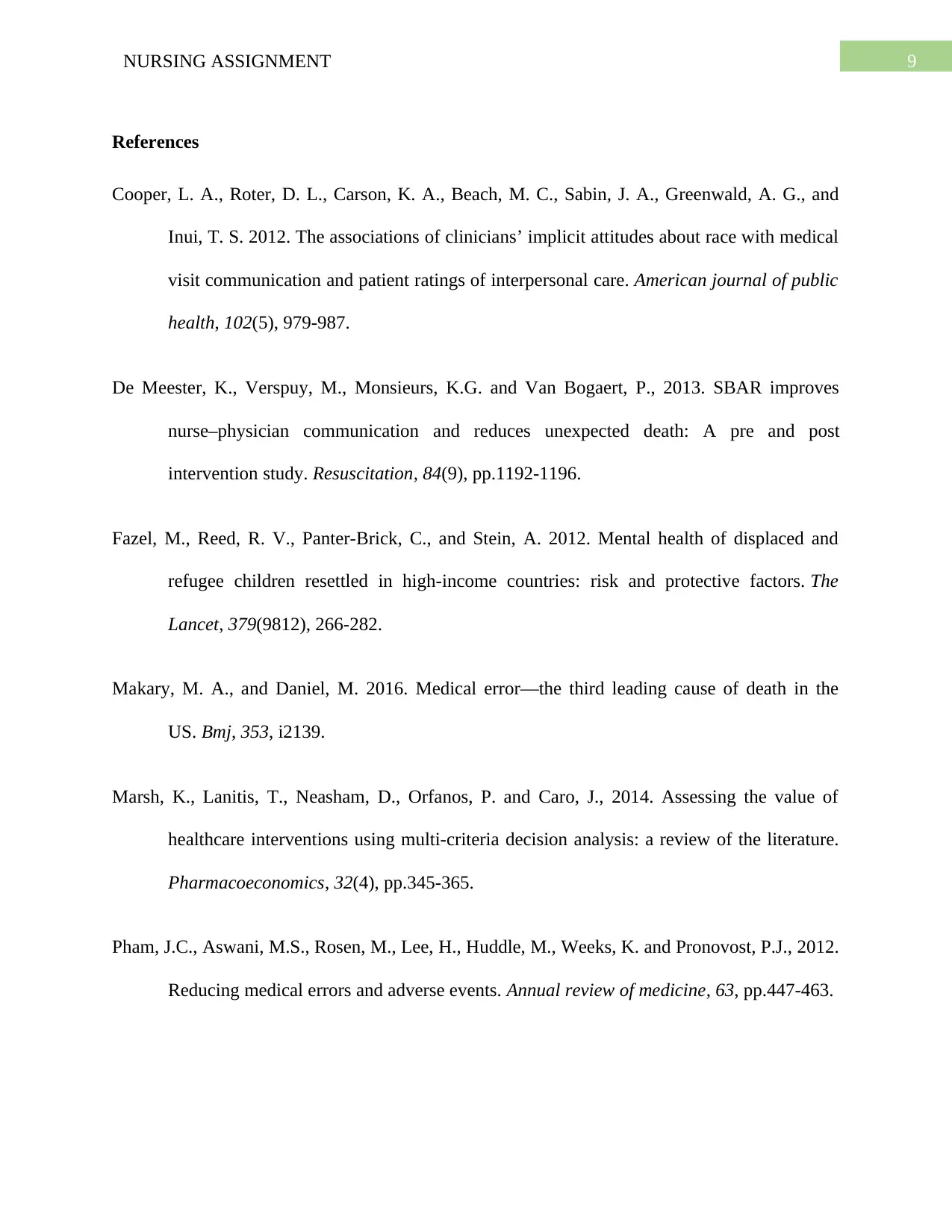
9NURSING ASSIGNMENT
References
Cooper, L. A., Roter, D. L., Carson, K. A., Beach, M. C., Sabin, J. A., Greenwald, A. G., and
Inui, T. S. 2012. The associations of clinicians’ implicit attitudes about race with medical
visit communication and patient ratings of interpersonal care. American journal of public
health, 102(5), 979-987.
De Meester, K., Verspuy, M., Monsieurs, K.G. and Van Bogaert, P., 2013. SBAR improves
nurse–physician communication and reduces unexpected death: A pre and post
intervention study. Resuscitation, 84(9), pp.1192-1196.
Fazel, M., Reed, R. V., Panter-Brick, C., and Stein, A. 2012. Mental health of displaced and
refugee children resettled in high-income countries: risk and protective factors. The
Lancet, 379(9812), 266-282.
Makary, M. A., and Daniel, M. 2016. Medical error—the third leading cause of death in the
US. Bmj, 353, i2139.
Marsh, K., Lanitis, T., Neasham, D., Orfanos, P. and Caro, J., 2014. Assessing the value of
healthcare interventions using multi-criteria decision analysis: a review of the literature.
Pharmacoeconomics, 32(4), pp.345-365.
Pham, J.C., Aswani, M.S., Rosen, M., Lee, H., Huddle, M., Weeks, K. and Pronovost, P.J., 2012.
Reducing medical errors and adverse events. Annual review of medicine, 63, pp.447-463.
References
Cooper, L. A., Roter, D. L., Carson, K. A., Beach, M. C., Sabin, J. A., Greenwald, A. G., and
Inui, T. S. 2012. The associations of clinicians’ implicit attitudes about race with medical
visit communication and patient ratings of interpersonal care. American journal of public
health, 102(5), 979-987.
De Meester, K., Verspuy, M., Monsieurs, K.G. and Van Bogaert, P., 2013. SBAR improves
nurse–physician communication and reduces unexpected death: A pre and post
intervention study. Resuscitation, 84(9), pp.1192-1196.
Fazel, M., Reed, R. V., Panter-Brick, C., and Stein, A. 2012. Mental health of displaced and
refugee children resettled in high-income countries: risk and protective factors. The
Lancet, 379(9812), 266-282.
Makary, M. A., and Daniel, M. 2016. Medical error—the third leading cause of death in the
US. Bmj, 353, i2139.
Marsh, K., Lanitis, T., Neasham, D., Orfanos, P. and Caro, J., 2014. Assessing the value of
healthcare interventions using multi-criteria decision analysis: a review of the literature.
Pharmacoeconomics, 32(4), pp.345-365.
Pham, J.C., Aswani, M.S., Rosen, M., Lee, H., Huddle, M., Weeks, K. and Pronovost, P.J., 2012.
Reducing medical errors and adverse events. Annual review of medicine, 63, pp.447-463.
Paraphrase This Document
Need a fresh take? Get an instant paraphrase of this document with our AI Paraphraser
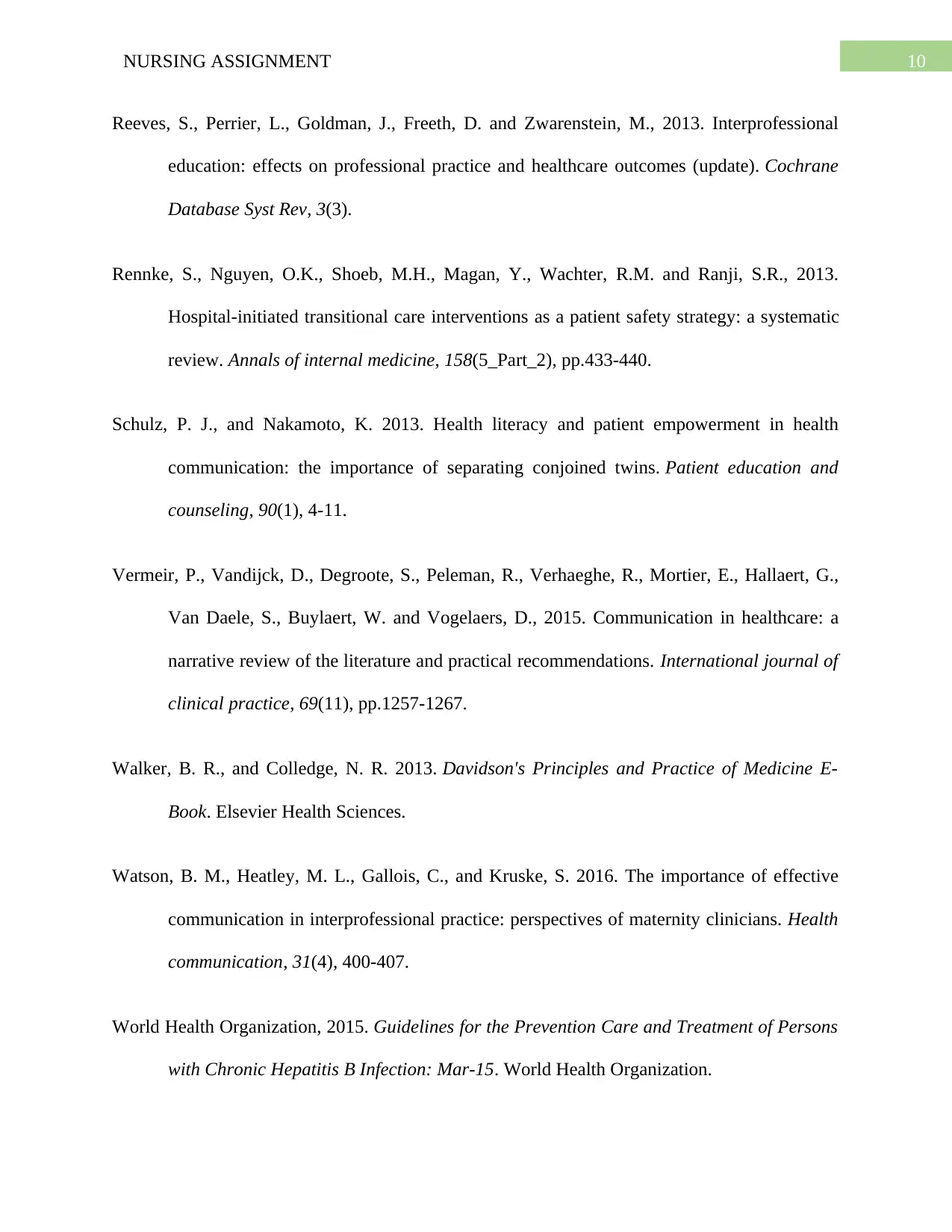
10NURSING ASSIGNMENT
Reeves, S., Perrier, L., Goldman, J., Freeth, D. and Zwarenstein, M., 2013. Interprofessional
education: effects on professional practice and healthcare outcomes (update). Cochrane
Database Syst Rev, 3(3).
Rennke, S., Nguyen, O.K., Shoeb, M.H., Magan, Y., Wachter, R.M. and Ranji, S.R., 2013.
Hospital-initiated transitional care interventions as a patient safety strategy: a systematic
review. Annals of internal medicine, 158(5_Part_2), pp.433-440.
Schulz, P. J., and Nakamoto, K. 2013. Health literacy and patient empowerment in health
communication: the importance of separating conjoined twins. Patient education and
counseling, 90(1), 4-11.
Vermeir, P., Vandijck, D., Degroote, S., Peleman, R., Verhaeghe, R., Mortier, E., Hallaert, G.,
Van Daele, S., Buylaert, W. and Vogelaers, D., 2015. Communication in healthcare: a
narrative review of the literature and practical recommendations. International journal of
clinical practice, 69(11), pp.1257-1267.
Walker, B. R., and Colledge, N. R. 2013. Davidson's Principles and Practice of Medicine E-
Book. Elsevier Health Sciences.
Watson, B. M., Heatley, M. L., Gallois, C., and Kruske, S. 2016. The importance of effective
communication in interprofessional practice: perspectives of maternity clinicians. Health
communication, 31(4), 400-407.
World Health Organization, 2015. Guidelines for the Prevention Care and Treatment of Persons
with Chronic Hepatitis B Infection: Mar-15. World Health Organization.
Reeves, S., Perrier, L., Goldman, J., Freeth, D. and Zwarenstein, M., 2013. Interprofessional
education: effects on professional practice and healthcare outcomes (update). Cochrane
Database Syst Rev, 3(3).
Rennke, S., Nguyen, O.K., Shoeb, M.H., Magan, Y., Wachter, R.M. and Ranji, S.R., 2013.
Hospital-initiated transitional care interventions as a patient safety strategy: a systematic
review. Annals of internal medicine, 158(5_Part_2), pp.433-440.
Schulz, P. J., and Nakamoto, K. 2013. Health literacy and patient empowerment in health
communication: the importance of separating conjoined twins. Patient education and
counseling, 90(1), 4-11.
Vermeir, P., Vandijck, D., Degroote, S., Peleman, R., Verhaeghe, R., Mortier, E., Hallaert, G.,
Van Daele, S., Buylaert, W. and Vogelaers, D., 2015. Communication in healthcare: a
narrative review of the literature and practical recommendations. International journal of
clinical practice, 69(11), pp.1257-1267.
Walker, B. R., and Colledge, N. R. 2013. Davidson's Principles and Practice of Medicine E-
Book. Elsevier Health Sciences.
Watson, B. M., Heatley, M. L., Gallois, C., and Kruske, S. 2016. The importance of effective
communication in interprofessional practice: perspectives of maternity clinicians. Health
communication, 31(4), 400-407.
World Health Organization, 2015. Guidelines for the Prevention Care and Treatment of Persons
with Chronic Hepatitis B Infection: Mar-15. World Health Organization.
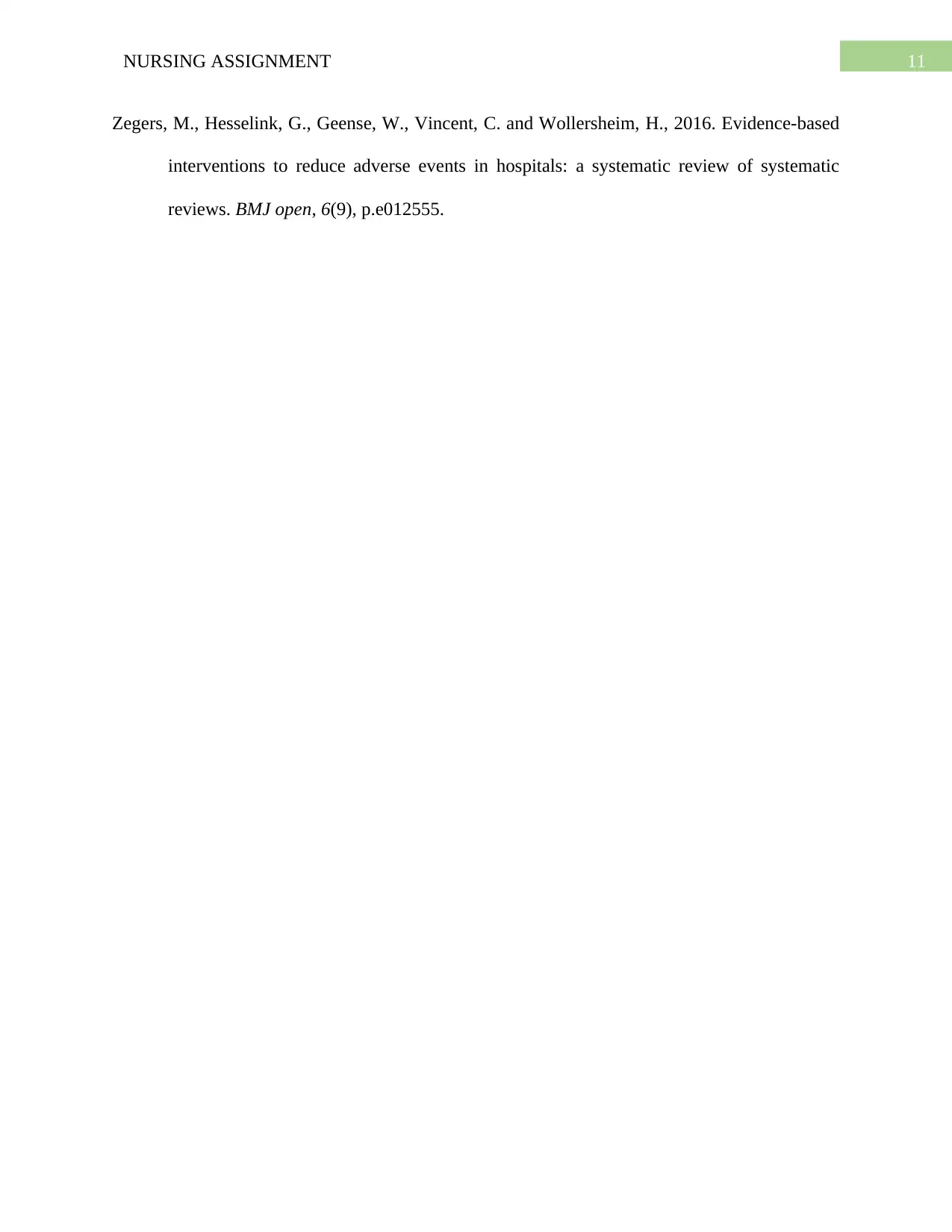
11NURSING ASSIGNMENT
Zegers, M., Hesselink, G., Geense, W., Vincent, C. and Wollersheim, H., 2016. Evidence-based
interventions to reduce adverse events in hospitals: a systematic review of systematic
reviews. BMJ open, 6(9), p.e012555.
Zegers, M., Hesselink, G., Geense, W., Vincent, C. and Wollersheim, H., 2016. Evidence-based
interventions to reduce adverse events in hospitals: a systematic review of systematic
reviews. BMJ open, 6(9), p.e012555.
⊘ This is a preview!⊘
Do you want full access?
Subscribe today to unlock all pages.

Trusted by 1+ million students worldwide
1 out of 12
Related Documents
Your All-in-One AI-Powered Toolkit for Academic Success.
+13062052269
info@desklib.com
Available 24*7 on WhatsApp / Email
![[object Object]](/_next/static/media/star-bottom.7253800d.svg)
Unlock your academic potential
Copyright © 2020–2025 A2Z Services. All Rights Reserved. Developed and managed by ZUCOL.





